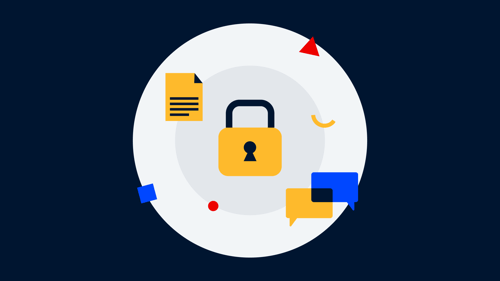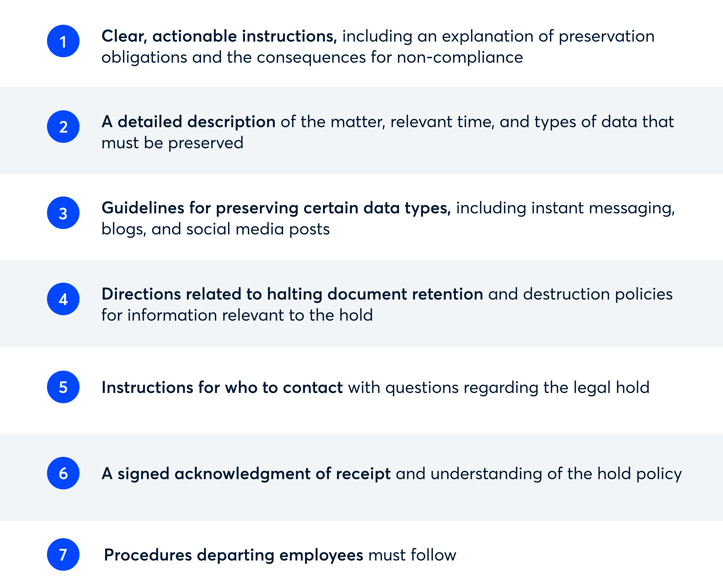What is a legal hold?

While most legal professionals are familiar with legal holds, that doesn’t mean they look forward to receiving one. While properly executing a legal hold doesn’t have to be complicated, compliance requires careful planning and preparation.
What is a legal hold (litigation hold)?
A legal hold, also known as a litigation hold, is the process organizations use to inform relevant parties (custodians) that they must preserve their data for anticipated litigation. The duty to preserve evidence can be court-ordered or self-initiated for internal investigations, breach of contract, or a complaint that could trigger or threaten litigation.
A legal hold applies to hard copies of documents – logs, notes, forms, bulletins, photographs, appointment books, and any other type of physical records – and to electronically stored information (ESI), including any relevant electronic data, no matter the format or storage method.
The importance of legal holds in eDiscovery
A legal hold prevents the spoliation of evidence to ensure that a plaintiff will have fair access to any information that might be relevant to their case. Rule 37(e) of the Federal Rules of Civil Procedure (FRCP) addresses sanctions for failure to preserve ESI, including potential jury instructions revealing that the lost information was unfavorable to the party or even case dismissal or default judgment. Disputes over the spoliation of evidence and resulting sanctions requests are among the most common eDiscovery disputes every year.
The timing of a legal hold can impact an entire case. In Zubulake v. UBS Warburg, the court ruled that evidence should have been preserved before filing the case. “Once a party reasonably anticipates litigation, it must suspend its routine document retention/destruction policy and put in place a ‘litigation hold’ to ensure the preservation of relevant documents.” The plaintiff’s motion for adverse inference instruction sanctions was granted, and the jury ultimately awarded $29.2 million in damages.
The legal hold process
Traditionally a manual procedure, legal holds are now highly automated with technology. The process typically includes the following steps:
- Preserve data: Potentially responsive data could consist of email, office files, data from enterprise systems, mobile device data, and collaboration app data. In-place preservation is beginning to replace preservation through collection as the preferred way to preserve data sources.
- Identify custodians: With 89 to 187 applications deployed within most organizations, anyone possessing responsive data, including employees and contractors, could be considered a relevant data source.
- Define scope: While preservation scope varies and is frequently negotiated between the parties, FRCP Rule 26(b)(1) requires that discovery be proportional. Centralizing the preservation and collection of potentially responsive data enables an organization to manage the scope effectively.
- Provide notice: Legal hold notices are commonly issued when there is reasonable anticipation of litigation. The notice should outline the custodian’s obligations, identify the issues, specify the related entities and date range, include instructions for preservation, and provide contact information to address questions.
- Track and report responses: Organizations must track responses acknowledging receipt of the hold notice and follow up with non-responsive custodians. Legal hold solutions automatically track responses and provide reports to identify non-responsive custodians for follow-up noticing.
- Release holds: Legal holds are often initially broad, with holds released on selected custodians when the duty to preserve is over. The hold is released for all custodians when the case ends; however, the affected data does not return to a regular disposition schedule if holds from other matters remain.
A defensible legal hold process will help prevent adverse outcomes, avoid legal sanctions, and minimize organizational risk. As a result, many organizations have automated the legal hold process.
Common legal hold challenges
Several issues with the traditional legal hold process can result in data spoliation and non-compliance, putting an organization at risk. These include:
- Manual processes. Manual legal hold processes, such as tracking custodians with a spreadsheet, are time-consuming and error-prone. Manual follow-up and re-notification are often necessary to confirm that custodians have received the hold, remind them to preserve data, and advise them of the ramifications of non-compliance.
- Software fragmentation. Utilizing different software platforms during the legal hold process can lead to fragmentation and increased security vulnerabilities. An integrated tool is a better, more cost-effective way to manage legal holds since all the work can be kept securely in one place.
- Scalability. Many larger organizations face ongoing litigation (or the threat of it) and routinely handle numerous legal holds simultaneously. Since each matter might involve hundreds of custodians, the process can quickly become unmanageable. However, scalability is possible when you have a solution that administers and organizes legal holds and grows with your organization.
Legal hold software helps manage the process by automating the issuing of holds, sending notifications and reminders, interviewing custodians, monitoring compliance, tracking progress, and preserving relevant information.
Legal hold best practices
Before addressing preservation and legal holds, an organization must have sound data retention and information governance policies in place to effectively manage the data subject to holds. General best practices for conducting a defensible legal hold include:

No matter how your team handles a legal hold, there are always opportunities to expedite your process to ensure a comprehensive and defensible collection across all information sources.
Streamline your legal hold process
The Onna platform simplifies and expedites the legal hold process to help teams manage preservation and centralize the information subject to the legal hold in one secure place.
To find out more, check out our data retention policy template and get started today.
 eDiscovery
eDiscovery Collections
Collections Processing
Processing Early Case Assessment
Early Case Assessment Information Governance
Information Governance Data Migration
Data Migration Data Archiving
Data Archiving Platform Services
Platform Services Connectors
Connectors Platform API
Platform API Pricing Plans
Pricing Plans Professional Services
Professional Services Technical Support
Technical Support Partnerships
Partnerships About us
About us Careers
Careers Newsroom
Newsroom Reveal
Reveal Logikcull by Reveal
Logikcull by Reveal Events
Events Webinars
Webinars OnnAcademy
OnnAcademy Blog
Blog Content Library
Content Library Trust Center
Trust Center Developer Hub
Developer Hub